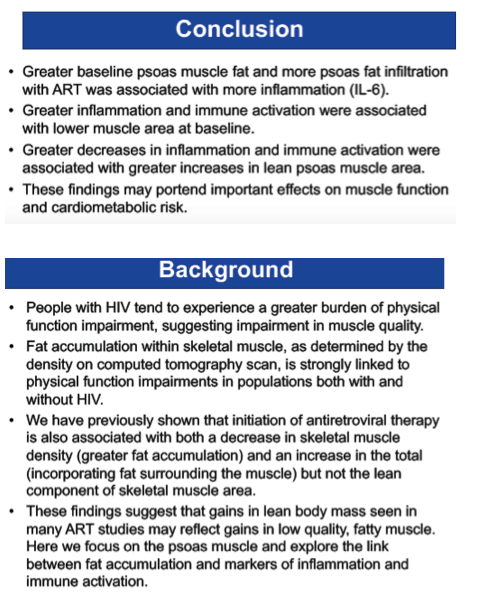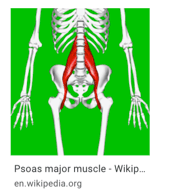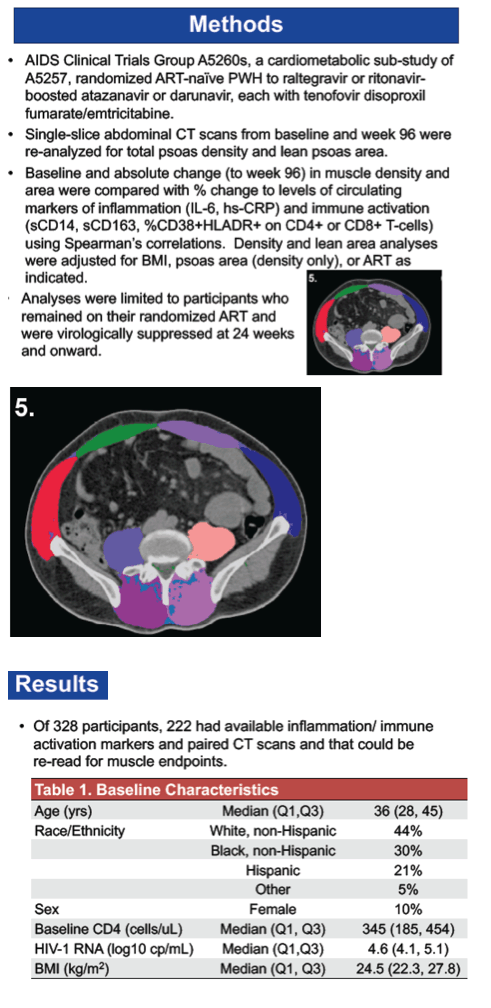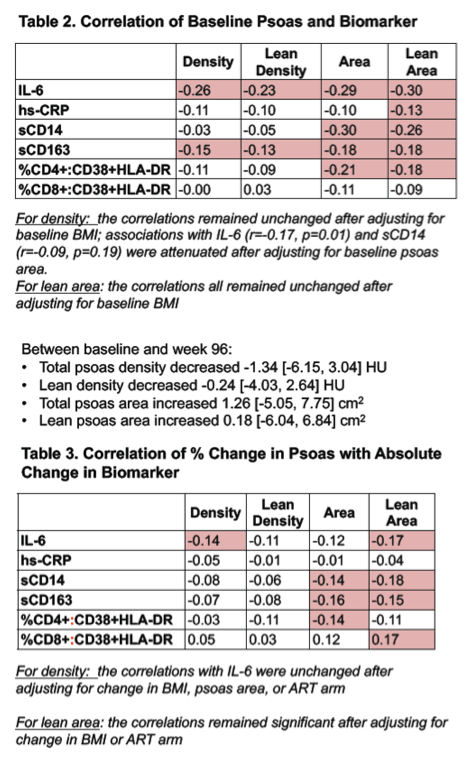 |
 |
 |
| |
Poorer Muscle Quality and Quantity with ART Initiation is Associated
with Greater Inflammation and Immune Activation
|
| |
| |
"We have previously shown that initiation of antiretroviral therapy is also associated with both a decrease in skeletal muscle
density (greater fat accumulation) and an increase in the total (incorporating fat surrounding the muscle) but not the lean component of skeletal muscle area...... findings suggest that gains in lean body mass seen in many ART studies may reflect gains in low quality, fatty muscle. Here we focus on the psoas muscle and explore the link between fat accumulation and markers of inflammation and immune activation."
10th International Workshop on HIV and Aging, October 10-11, 2019, New York
Reported by Jules Levin
Kristine M. Erlandson1, Stefan Adrian1, Carlee Moser2, Maxine Olefsky2, Todd T. Brown3, Judith S. Currier4,
Grace A. McComsey5, Ann Scherzinger1, James H. Stein6, Jordan E. Lake7
1. University of Colorado School of Medicine, 2. Harvard T.H. Chan School of Public Health,
3. University of Colorado College of Nursing

psoas muscle-the long muscle (up to 16 inches) in your back-is injured. The psoas muscle is located in the lower lumbar region of the spine and extends through the pelvis to the femur. This muscle works by flexing the hip joint and lifting the upper leg towards the body.

program abstract
Poorer muscle quality and quantity with ART initiation is associated with greater inflammation and immune activation
ERLANDSON K1, Moser C2, Olefsky M2, Brown T3, Currier J4, McComsey G5, Scherzinger A1, Stein J6, Lake J7
1University of Colorado Denver, Aurora, United States, 2Harvard T.H. Chan School of Public Health, Boston, United States, 3Johns Hopkins University, Baltimore, United States, 4University of California Los Angeles, Los Angeles, United States, 5Case Western Reserve University, Cleveland, United States, 6University of Wisconsin, Madison, United States, 7University of Texas Health Sciences Center at Houston, Houston, United States
Background: People with HIV (PWH) tend to experience a greater burden of physical function impairment, suggesting impairment in muscle quality. Fat accumulation within skeletal muscle, as determined by the density on computed tomography (CT) scan, is strongly linked to physical function impairments in populations both with and without HIV. We have previously shown that initiation of antiretroviral therapy is also associated with both a decrease in skeletal muscle density (greater fat accumulation) and an increase in total fat (includes fat surrounding the muscle) but not the lean component of skeletal muscle area. These findings suggest that gains in lean body mass seen in many ART studies may reflect gains in low quality, fatty muscle. Here we focus on the psoas muscle and explore the link between fat accumulation and markers of inflammation and immune activation.
Methods: AIDS Clinical Trials Group A5260s, a cardiometabolic sub-study of A5257, randomized ART-na´ve PWH to raltegravir or ritonavir-boosted atazanavir or darunavir, each with tenofovir disoproxil fumarate/emtricitabine. Single-slice abdominal CT scans from baseline and week 96 were re-analyzed for total psoas density and lean psoas area. We compared baseline and week 96 muscle density and area and % change to levels of circulating markers of inflammation (IL-6, hs-CRP) and immune activation (sCD14, sCD163, %CD38+HLADR+ on CD4+ or CD8+ T-cells) using Spearman's correlations. Analyses were limited to participants with virologic suppression who remained on their randomized ART at 24 weeks and beyond.
Results: Of 328 participants, 222 had available inflammation/ immune activation markers and paired CT scans and that could be re-read for muscle endpoints. The majority of participants were male (90%) with a median age 36 (IQR 28-45) years and BMI 24.5 kg/m2 (22.3-27.8); 44% were white; 30% black and 21% Hispanic.
At baseline, lower total psoas density (greater fat) correlated with higher IL-6 (r -0.26, p<0.001) and sCD163 (r -0.15, p=0.03) concentrations. Lower baseline lean psoas area correlated with higher IL-6 (r -0.30), hs-CRP (-0.13), sCD14 (r -0.26), sCD163 (r -0.18), and %CD38+HLADR+ on CD4+ T-cells (r -0.18; all p≤0.05). Between baseline and week 96, small decreases in total psoas density (media -1.34 [-6.15, 3.04]) and increases in lean psoas area (0.18 [-6.04, 6.84])were seen. At week 96, lower total psoas density correlated with higher IL-6 (r -0.24), hs-CRP (r -0.28; both p<0.001), and weakly with sCD163 (r -0.12; p=0.07); lean psoas area correlated with hs-CRP (r-0.15; p=0.03). Greater % decrease in total psoas density (more fat) correlated with greater increase in IL-6 (r -0.14; p=0.04); greater % decrease in lean psoas area correlated greater increase in IL-6, sCD14, sCD163, and %CD38+HLADR+ on CD8+ T-cells (r -0.15 to -0.18; all p<0.04).
Discussion: Greater fat infiltration within the psoas muscle (lower density) and greater loss in lean psoas muscle was associated with higher inflammation and immune activation, which may portend important effects on muscle function and cardiometabolic risk.


|
| |
|
 |
 |
|
|